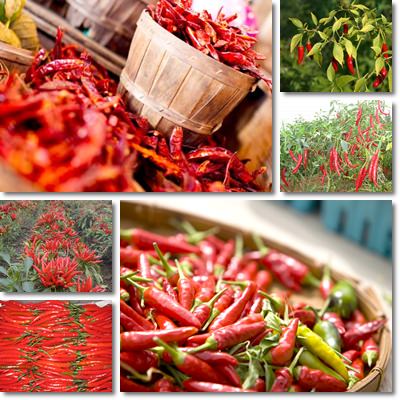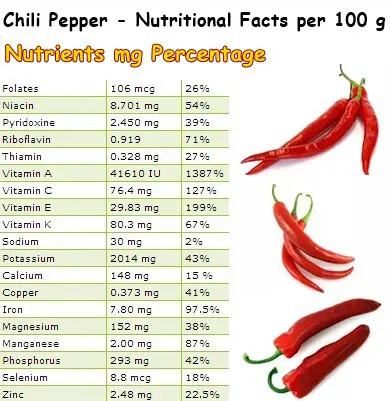Hot and spicy, chili (or chilli) peppers are not for the weak. There are few plants in nature with such a high content of vitamins, minerals and antioxidants such as chili peppers. But then again, very few can reach the spiciness of chili peppers. This hot, vitamin-packed culinary vegetable is a pleasure for the eyes, a blessing for our health, yet not so palatable when it comes to the more pungent varieties, but absolutely health. From relieving nasal congestion and boosting immunity to improving vision, restoring vitality, promoting thyroid and bone health, chili peppers are good for you.
Chili peppers active ingredient
Unlike bell peppers, chili peppers contain a pungent natural alkaloid substance called capsaicin which is responsible for the sometimes unbearable spiciness or hotness of many pepper varieties. Capsaicin is responsible for both the most impressive health benefits of the peppers, and for their least enjoyable side effects. Anyone suffering from gastritis, acid reflux, heartburn, hemorrhoids or other similar ailments is best off avoiding these spicy peppers because, for them, the side effects may greatly outweigh the benefits.

Chili peppers nutrition facts and benefits
Capsaicin-rich chili peppers are a must on one’s plate. According to scientific research, capsaicin is a strong natural anti-bacterial, anti-diabetic, analgesic and anticancer agent. It is the main ingredient in many analgesic creams, ointments and gels that seek to provide temporary relief against a variety of pains. Capsaicin prescription-free creams are used topically to numb arthritis pain, muscle strains and backaches as a result of the excellent analgesic properties of the substance. Being a strong antimicrobial, capsaicin is used to reduce itching in various skin conditions.
How does the capsaicin in chili peppers relieve pain?
Capsaicin is actually not a pain reliever, but a numbing agent. The hotness or strong heat sensation we feel at the level of the mouth when eating hot chili peppers is a result of capsaicin triggering a response in pain receptors, hence the unbearable nature of the eating experience. When applied topically, capsaicin puts our pain receptors under such strain that they cannot transmit pain any more. As soon as this over-excitement wears off, we start feeling pain again.
Some studies even report that the capsaicin and other capsaicinoid compounds in chili peppers may promote lower triglyceride and LDL cholesterol levels, when used judiciously. In addition to strong antibacterial, anti-inflammatory and analgesic properties, chili peppers boast an incredible nutritional value. Both green and red chili peppers provide 76.4 mg of vitamin C/100 g, which amounts to an astonishing 127% of the RDI. As you may already know, vitamin C is a powerful antibacterial, anti-inflammatory and antioxidant with impressive effect on the health of multiple systems, notably the cardiovascular and immune system.

Vitamin C-rich foods increase immunity, prevent wrinkles by stimulating collagen production, reduce inflammation and offer antioxidant protection against harmful reactive oxygen molecules called free radicals. Having enough of the nutrient in your system has been shown to contribute to a reduction in chronic disease risks and helps reduce the frequency, duration and severity of colds and other respiratory tract infections.
Chili peppers are the richest in vitamin A of all spices: 41 610 IU, equivalent to 1387% of the RDI of vitamin A. Additionally, they contain provitamin A antioxidants such as beta-carotene, lutein, zeaxanthin and cryptoxanthin. This means that regular consumption is highly beneficial for eye, skin, lungs and mucous membranes health.
Lutein and zeaxanthin in particular maintain a healthy retina and prevent macular degeneration, which is loss of central vision occurring due to old age. Both antioxidant pigments accumulate in the retina and shield it from free radicals from light, preventing damage that may lead to loss of vision. With such a high amount of vitamin A, chili peppers maintain healthy mucous membranes, protect the lungs from first and second hand smoking and the skin from free radical damage.

Chili peppers supply us with 199% of the RDI of vitamin E for every 100 g, rivaling with sunflower seeds, walnuts, papaya, turnip greens, chard and bell peppers, some of the best plant sources of the nutrient. This powerful fat-soluble antioxidant vitamin offers antioxidant protection to the skin, thus preventing the development of skin cancers, and promotes cognitive health in older individuals. The peppers provide excellent amounts of vitamin K (67%) and thus support calcium absorption in bones and blood coagulation, prevent osteoporosis and atherosclerosis.
Chili peppers are especially rich in essential minerals such as iron (97%), manganese (87%), phosphorus (42%), copper (41%), potassium (43%), magnesium (38%) and zinc (22%). With such a good mineral content, regular consumption promotes a faster recovery after anemia, offers antioxidant protection for the prevention of chronic diseases, ensures strong teeth and bones, delays hair graying and eye discoloration.
Moreover, chili consumption helps regulate body fluids, heart rate and blood pressure as a result of a good potassium content, promotes muscle health and ensures good immunity. You can read more on the properties and health benefits of vitamins and minerals and on the best food sources of a nutrient of your interest on the vitamins and minerals page which you can find in the menu above.
Chili peppers side effects and contraindications
Overall, chili peppers make a great addition to any diet because of their incredible nutritional value and outstanding health benefits that come with it. As with any other food, moderation is imperative. Eating too many chili peppers can result in side effects such as heartburn, indigestion, upset stomach, and for those with gastritis, acid reflux disease (GERD), peptic ulcer and other digestive conditions, worse symptoms, hemorrhoids flareups, abdominal pain etc.
Find out more the side effects of hot chili peppers.
I keep three small pots of an edible ornamental chili variety in the kitchen during winter. Whenever I want to add some spice to my food, I add two small, spicy peppers in the pan or eat one raw along with a favorite dish, depending on what I am cooking. I find this to be handy and seeing the three little pots of green, purple, yellow and red hot peppers in my kitchen brightens my days like seeing spring flowers in midwinter. Even though I have to watch what I eat due to a history of gastritis and acid reflux disease, so long as I keep intake minimal, and infrequent, I only get the benefits from my chili peppers, without any of the side effects.
